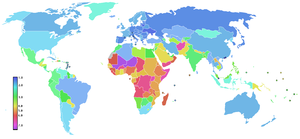
There is a popular myth that population growth alone determines our impact on the environment.[1] In reality though, it is the combination of both the population size, as the (degree of) participation of each member on the economy, as the way in which each member chooses to use this wealth that determines this.[2]
That being said, the decision of not reproducing is one of the most effective actions we can take. In practice, some families will be able to propagate and some not as we are all entitled to about 0,57 children.[3][4] This does not mean of course that we can not have any children at all, because adoption is still an option, as this does not increase the population size.
See also[edit | edit source]
Notes and references[edit | edit source]
- ↑ http://www.urbansprout.co.za/population_growth_has_no_relation_to_global_warming
- ↑ For example, someone with millions on his bank account can decide to park it there until he dies, while someone with a limited budget can still have a major negative impact on the environment (e.g. by starting a forest fire) and/or can also have other negative impacts (e.g. by disposing all his organically non-decomposable waste in the environment).
- ↑ Having 2 children maintains population size, divided by 3,5 makes 0,57
- ↑ The decision on who can and can not reproduce will probably depend on financial means (to be able to support children), and genetic makeup
External links[edit | edit source]
- Falling fertility, The Economist, Oct 29th 2009. Argues that there is little more to be achieved in developed countries through population policy, as growth is already falling about as fast as can be expected. Thus emissions reductions in these countries must come through technology and governance.